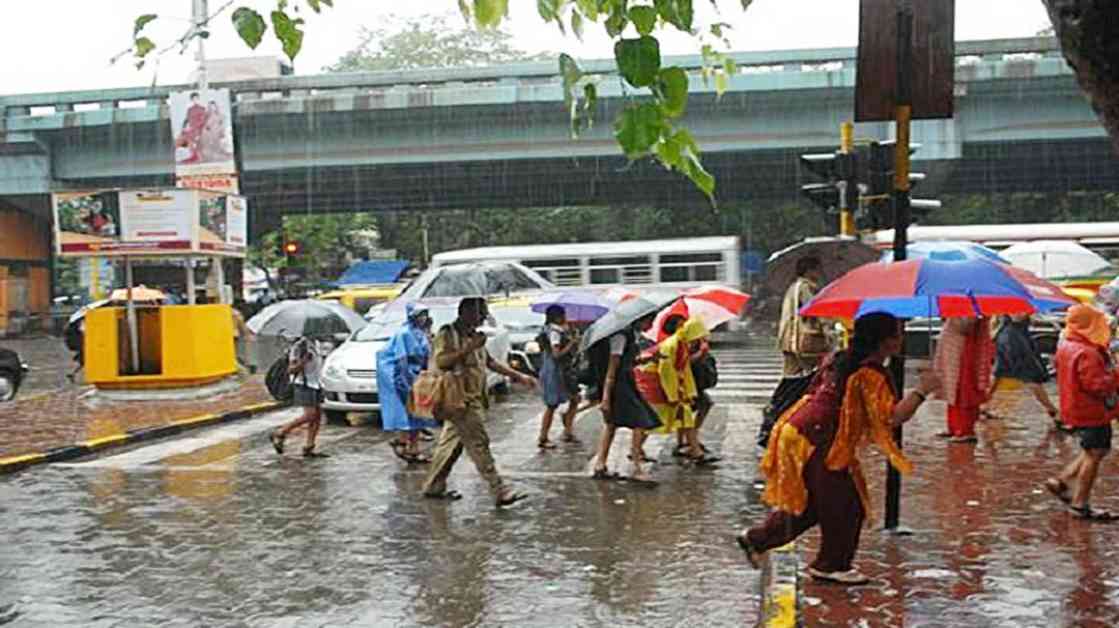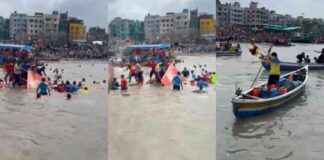Heavy Rainfall Pounds Mumbai and Thane, Causing Chaos Until September 26
As the monsoon season begins to wane, Mumbai and Thane are being pummeled by heavy rainfall and thunderstorms, causing widespread chaos and disruption. The India Meteorological Department (IMD) has issued a red alert for these areas, as well as Palghar, until Thursday, September 26, warning residents to brace for heavy to very heavy rainfall accompanied by thunderstorms, lightning, and gusty winds at isolated locations.
The Met Department has further cautioned that there is a possibility of “very heavy rainfall at isolated places towards night and early morning,” heightening concerns for potential flooding and hazards. This warning extends beyond Mumbai and Thane, with other districts across Maharashtra also facing a red alert for September 26, predicting extremely heavy rainfall and thunderstorms with lightning and gusty winds at isolated locations.
In the past 24 hours leading up to 8:30 am on September 25, Mumbai recorded 74 mm of rainfall, as reported by TOI. Additionally, the IMD Santacruz observatory noted 75 mm of rain in the preceding 24 hours up to 8:30 am on September 24. These rainfall figures fall within the heavy rain category according to the IMD’s classification, indicating the intensity of the ongoing weather conditions.
The current weather pattern is characterized by thunderstorm activity, resulting in short yet intense bursts of rain that have led to significant waterlogging in various parts of the city. As a consequence, the Andheri subway was temporarily closed on Wednesday afternoon to mitigate flooding risks. Areas such as Mulund, Thane, Panvel, Kharghar, and Kamothe have experienced particularly intense rainfall activity, exacerbating the challenges faced by residents and local authorities.
Notably, Mumbai saw its first heavy rain spell for the month of September in the early hours of Tuesday, September 24. An IMD official highlighted that the majority of this rainfall occurred between 2:30 am and 4:30 am on both Tuesday and Wednesday nights, surprising residents with sudden downpours and thunderous sounds that disrupted their sleep.
Looking ahead, the IMD’s latest weather update suggests that the rains are expected to taper off by Friday, September 27, and Saturday, September 28, prompting a green alert for the city over the weekend. During this period, temperatures are anticipated to rise slightly, with moderate rainfall still lingering in the forecast.
As we approach September 29 and 30, temperatures are projected to range from 26 degrees Celsius to 31 degrees Celsius, with reduced chances of rain. Despite this temporary respite, residents are advised to remain prepared for wet weather conditions throughout the week, as the monsoon season continues to make its presence felt in the region.
Impacts of Heavy Rainfall
The heavy rainfall and thunderstorms plaguing Mumbai and Thane have had far-reaching consequences, affecting various aspects of daily life for residents. Public transportation systems have been disrupted, with trains and buses experiencing delays and cancellations due to waterlogging on tracks and roads. As a result, commuters have been left stranded, struggling to navigate through flooded streets and reach their destinations.
Moreover, the heavy rain has caused significant damage to infrastructure, including roads, buildings, and utilities. Reports of landslides and collapses have surfaced in hilly areas, posing risks to residents and exacerbating the challenges faced by emergency response teams. Power outages have also been reported in some areas, further complicating the situation for residents already grappling with the impact of the inclement weather.
In addition to physical damage, the heavy rainfall has taken a toll on the mental and emotional well-being of residents. The constant threat of flooding, waterlogging, and related hazards has heightened anxiety and stress levels, particularly among vulnerable populations such as the elderly, children, and individuals with pre-existing health conditions. The uncertainty surrounding the duration and intensity of the rainfall has added to the sense of unease and insecurity among residents, prompting calls for increased support and assistance from authorities.
Preparedness and Response Measures
In light of the ongoing heavy rainfall and adverse weather conditions, it is crucial for residents to prioritize their safety and well-being by taking proactive measures to mitigate risks and stay informed. The following preparedness and response measures are recommended to help individuals and communities cope with the challenges posed by the inclement weather:
1. Stay Informed: Keep abreast of weather updates and advisories issued by the IMD and local authorities to stay informed about evolving weather conditions and potential hazards. Follow official channels and credible sources for accurate information and guidance on how to respond to emergencies.
2. Prepare an Emergency Kit: Assemble a basic emergency kit containing essential items such as non-perishable food, water, medication, first aid supplies, flashlight, batteries, and important documents. Ensure that your emergency kit is easily accessible and ready for use in case of evacuation or sheltering in place.
3. Secure Your Property: Take proactive steps to safeguard your home and belongings against water damage and flooding. Clear gutters and drains of debris, secure loose objects that could become projectiles in strong winds, and reinforce vulnerable areas of your property to minimize potential risks.
4. Evacuation Planning: Develop an evacuation plan in collaboration with your family members or household to ensure that everyone knows what to do in case of a mandatory evacuation order. Identify evacuation routes, emergency shelters, and safe assembly points in your community to facilitate a swift and organized response during emergencies.
5. Stay Connected: Maintain open lines of communication with your neighbors, friends, and family members to share information, resources, and support during times of crisis. Check on vulnerable individuals in your community, such as elderly neighbors or those with mobility issues, to offer assistance and ensure their safety and well-being.
By implementing these preparedness and response measures, residents can enhance their resilience and readiness to cope with the challenges posed by heavy rainfall and adverse weather conditions. Collaborating with local authorities, community organizations, and emergency response agencies can also strengthen collective efforts to mitigate risks, reduce vulnerabilities, and ensure the safety and security of all residents in the face of natural disasters and emergencies.
Conclusion: Navigating Through the Storm
As Mumbai and Thane grapple with the onslaught of heavy rainfall and thunderstorms, residents are urged to remain vigilant, prepared, and resilient in the face of ongoing challenges. While the inclement weather may pose significant disruptions and risks, it also presents an opportunity for communities to come together, support one another, and strengthen their capacity to respond effectively to emergencies.
By prioritizing safety, communication, and collaboration, residents can navigate through the storm with resilience and determination, emerging stronger and more prepared to face future challenges. As the monsoon season gradually recedes and gives way to clearer skies, the lessons learned from this period of adversity can serve as a foundation for building a more secure, sustainable, and resilient future for Mumbai, Thane, and the surrounding areas. Together, we can weather the storm and emerge stronger on the other side, united in our commitment to safeguarding our communities and ensuring the well-being of all residents.




















